
In today’s digital landscape, your website is often the first impression potential customers have of your business. A smoothly functioning, secure, and up-to-date website inspires trust and drives conversions. With WordPress powering over 43% of the web, neglecting its maintenance can be detrimental, especially for businesses reliant on online interactions. Enter effective WordPress maintenance practices, the crucial tools for keeping your website a well-oiled machine that fuels your business success.
Fortress of Security: Guarding Your Digital Doorstep
1. Lock it Down: Implement strong passwords and two-factor authentication for your admin account. Use complex, unique passwords for each login and avoid easily guessable combinations.
2. Patchwork Perfection: Regularly update WordPress core, themes, and plugins. These updates often include security patches and bug fixes, keeping your website resilient against vulnerabilities.
3. Plugin Patrol: Be mindful of plugin usage. Only install plugins from trusted sources and regularly check for compatibility updates. Deactivate and delete unused plugins to minimize security risks.
4. Security Scanner Savvy: Utilize trusted security plugins like Wordfence or Sucuri to scan for malware, vulnerabilities, and suspicious activity. Schedule regular scans and act promptly on any identified issues.
5. Backup Brigade: Don’t let data loss bring your business to its knees. Implement automated backups of your website files and database. Consider storing backups remotely for added security in case of server issues.
Performance Optimization: Speed Up Your Success
1. Caching Champion: Implement caching plugins to speed up page load times. Cached versions of pages are served to visitors, minimizing server load and improving user experience.
2. Image Optimization: Large images can drastically slow down your website. Resize and compress images before uploading them to maintain visual quality while reducing file size.
3. Plugin Pruning: Regularly review your plugins and deactivate those you no longer use. Active plugins add code to your website, impacting performance. Keep only the essential ones running.
4. Database Detox: Over time, your database can accumulate unnecessary data. Use plugins to identify and clean up orphaned post revisions, spam comments, and other data fragments.
5. Hosting Hero: Choose a reliable web hosting provider with sufficient resources to handle your website traffic. Shared hosting might not be sufficient for high-traffic sites, consider managed WordPress hosting for optimal performance.
Content & Optimization: Engaging Your Audience & Search Engines
1. Freshness Factor: Regularly publish new content to keep your website engaging and relevant. This also signals activity to search engines, potentially boosting your ranking.
2. SEO Smarts: Optimize your website for search engines. Use relevant keywords in your content, meta descriptions, and titles. Consider plugins like Yoast SEO for guidance.
3. Broken Link Brigade: Check for broken links and fix them promptly. Broken links frustrate users and harm your website’s SEO.
4. Mobile Marvel: Ensure your website is mobile-friendly. Responsive design is crucial in today’s mobile-first world. Use themes and plugins designed for mobile responsiveness.
5. Accessibility Advocate: Make your website accessible to everyone. Use alt text for images, clear font sizes and colors, and keyboard navigation options.
Beyond the Basics: Advanced Practices for Proactive WordPress Warriors
1. Staging Site Savior: Set up a staging site to test updates and changes before making them live on your main website. This minimizes the risk of breaking something on your live site.
2. Development Sandbox: Consider using a local development environment to build and test new features before deploying them to your live site.
3. Monitoring Maestro: Utilize uptime monitoring tools to track your website’s performance and availability. Be notified of any downtime quickly and address issues promptly.
4. Performance Profiling: Analyze your website’s performance with profiling tools to identify bottlenecks and optimize specific areas for faster loading times.
5. Security Audits: Periodically conduct security audits to identify any vulnerabilities you might have missed. Invest in professional audits for extra peace of mind.
Investing in Maintenance: A Smart Business Strategy
Remember, website maintenance is not a one-time task but an ongoing process. By adopting these practices and building a routine, you can ensure your WordPress website remains a secure, performing, and SEO-friendly hub for your business growth. Whether you handle maintenance yourself, leverage automation tools, or utilize managed WordPress services, the time and effort you invest will translate into a smooth-running digital storefront, satisfied customers, and ultimately, sustained business success.
Bonus Tip: Don’t forget to document your maintenance processes! This ensures continuity and ease of handover if someone else needs to take over website management in the future.
By prioritizing WordPress maintenance, you equip your business with a secure, fast, and user-friendly platform to thrive in the ever-evolving
